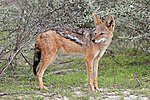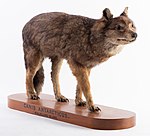Canini (tribe)
| Canini | |
|---|---|

| |
| Canina (represented by the golden jackal) and Cerdocyonina (represented by the crab-eating fox) | |
| Scientific classification | |
| Domain: | Eukaryota |
| Kingdom: | Animalia |
| Phylum: | Chordata |
| Class: | Mammalia |
| Order: | Carnivora |
| Family: | Canidae |
| Subfamily: | Caninae |
| Tribe: | Canini Fischer de Waldheim, 1817[2] |
| Genera[1] | |
| |
Canini is a taxonomic rank which represents the dog-like tribe of the subfamily Caninae (the canines), and is sister to the fox-like tribe Vulpini. The Canini came into existence 9 million years ago. This group was first represented by Eucyon, mostly by Eucyon davisi that was spread widely across North America.[1]
Taxonomy
The critical features that mark the Canini as a monophyletic group include the consistent enlargement of the frontal sinus, often accompanied by the correlated loss of the depression in the dorsal surface of the postorbital process; the posterior expansion of the paroccipital process; the enlargement of the mastoid process; and the lack of lateral flare of the orbital border of the zygoma.
Members of this tribe include:
| Subtribe | Description | Image | Genus | Species |
|---|---|---|---|---|
| Canina Fischer de Waldheim, 1817 | The wolf-like canines.[3] | 
|
Canis Linnaeus, 1758 |
|

|
Cuon Hodgson, 1838 |
| ||

|
Lupulella Hilzheimer, 1906 |
| ||

|
Lycaon Brookes, 1827 |
| ||

|
†Cynotherium Studiati, 1857 |
| ||

|
†Eucyon Tedford and Qiu (1996) |
| ||

|
†Aenocyon
Merriam, 1918 |
| ||
| Cerdocyonina Tedford et al., 2009 | The South American, fox-shaped canines. [3] | 
|
Speothos Lund, 1839 |
|

|
Atelocynus Cabrera, 1940 |
| ||

|
Chrysocyon Smith, 1839 |
| ||

|
†Dusicyon C. E. H. Smith, 1839 | |||

|
Lycalopex Burmeister 1854 |
| ||

|
Cerdocyon C. E. H. Smith, 1839 |
| ||
| †Nurocyon Sotnikova, 2006 |
| |||
| †Protocyon Giebel 1855 |
| |||
| †Theriodictis Mercerat, 1891 |
|
Common names of most of the South American canines include "fox", based on resemblance, but they are more closely related to wolves than to vulpini, the Eurasian and North American foxes.

The cladogram below is based on the phylogeny of Lindblad-Toh et al. (2005),[4] modified to incorporate recent findings on Canis species,[5] Lycalopex species,[6] and Dusicyon.[7]
| Canini |
| |||||||||||||||||||||||||||||||||||||||||||||||||||||||||
References
- ^ a b c d Tedford, Richard H.; Wang, Xiaoming; Taylor, Beryl E. (2009). "Phylogenetic Systematics of the North American Fossil Caninae (Carnivora: Canidae)" (PDF). Bulletin of the American Museum of Natural History. 325: 1–218. doi:10.1206/574.1. hdl:2246/5999.
- ^ Fischer de Waldheim, G. 1817. Adversaria zoological. Memoir Societe Naturelle (Moscow) 5:368–428. p372
- ^ a b Wayne, Robert K. (June 1993). "Molecular evolution of the dog family". Trends in Genetics. 9 (6): 218–224. doi:10.1016/0168-9525(93)90122-x. PMID 8337763.
- ^ Lindblad-Toh, Kerstin; Wade, Claire M.; Mikkelsen, Tarjei S.; Karlsson, Elinor K.; Jaffe, David B.; Kamal, Michael; et al. (2005). "Genome sequence, comparative analysis and haplotype structure of the domestic dog". Nature. 438 (7069): 803–819. Bibcode:2005Natur.438..803L. doi:10.1038/nature04338. PMID 16341006.
- ^ Koepfli, Klaus-Peter; Pollinger, John; Godinho, Raquel; Robinson, Jacqueline; Lea, Amanda; Hendricks, Sarah; et al. (2015). "Genome-wide evidence reveals that African and Eurasian Golden Jackals are distinct species". Current Biology. 25 (16): 2158–2165. doi:10.1016/j.cub.2015.06.060. PMID 26234211.
- ^ Tchaicka, Ligia; de Freitas, Thales Renato Ochotorena; Bager, Alex; Vidal, Stela Luengos; Lucherini, Mauro; Iriarte, Agustín; et al. (2016). "Molecular assessment of the phylogeny and biogeography of a recently diversified endemic group of South American canids (Mammalia: Carnivora: Canidae)" (PDF). Genetics and Molecular Biology. 39 (3): 442–451. doi:10.1590/1678-4685-GMB-2015-0189. PMC 5004827. PMID 27560989.
- ^ Slater, G.J.; Thalmann, O.; Leonard, J.A.; Schweizer, R.M.; Koepfli, K.-P.; Pollinger, J.P.; et al. (2009). "Evolutionary history of the Falklands wolf". Current Biology. 19 (20): R937–R938. doi:10.1016/j.cub.2009.09.018. hdl:10261/58562. ISSN 0960-9822. PMID 19889366.
External links
